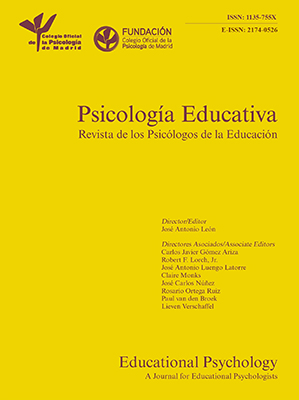
Un Modelo Predictivo de Conducta Disocial por Análisis de Senderos
[A Predictor Model of Dissocial Behavior by Path Análisis]
Moral de la Rubia, José Ortiz Morales, Humberto
https://doi.org/10.5093/jr2011v21a3
Resumen
Este trabajo tuvo como objetivos determinar un modelo predictivo de conducta disocial (ECODI27; Pacheco y Moral, 2010) con las variables de comunicación con los padres (PACS; Barnes y Olson, 1982), empatía (IRI; Davis, 1980), asertividad (RAS; Rathus, 1973), búsqueda de sensaciones (SSS-V; Zuckerman, Eysenck y Eysenck, 1978) y socialización de riesgo, tras parcializar manejo de impresión (BIDR-6; Paulhus, 1991). Se empleó una muestra probabilística de adolescentes que vivían en dos barrios con alto índice de pandillerismo (112 varones y 86 mujeres). Un tercio de los participantes mostró conducta disocial. Un modelo donde búsqueda de sensaciones, toma de perspectiva, comunicación con el padre y socialización de riesgo actuaban de forma directa y búsqueda de sensaciones correlacionaba con socialización marginal y comunicación con el padre presentó buen ajuste a los datos y explicó un tercio de la varianza de conducta disocial. Se insiste en la necesidad de intervención considerando este modelo.
Abstract
The aims of this paper were to determinate a predictive model of dissocial behaviour (ECODI27; Pacheco & Moral, 2010) with the variables of parent-adolescent communication (PACS; Barnes & Olson, 1982), empathy (IRI; Davis, 1980), asertivity (RAS; Rathus, 1973), sensation seeking (SSS-V; Zuckerman, Eysenck & Eysenck, 1978) and risk socialization (Social Relationship Questionnaire created for this study) after partializing impression management (BIDR-6; Paulhus, 1991). A probability sample of adolescents that lived in two neighborhoods with high indexes of gangs and offenses (112 male and 86 women) was collected. A third of the participants showed dissocial behavior. A model where the sensation seeking, perspective taking, father-adolescent communication and risk socialization acted in a way direct, and the sensation seeking correlated with marginal socialization and father-adolescent communication presented a good fit to the data and explained one thirds of the dissocial behavior variance. We insist on the need of intervention considering this model.
Palabras clave
Conducta disocial#búsqueda de sensaciones#manejo de la impresión#empatía#socializaciónCopyright © 2025. Colegio Oficial de la Psicología de Madrid








 CrossRef
CrossRef







